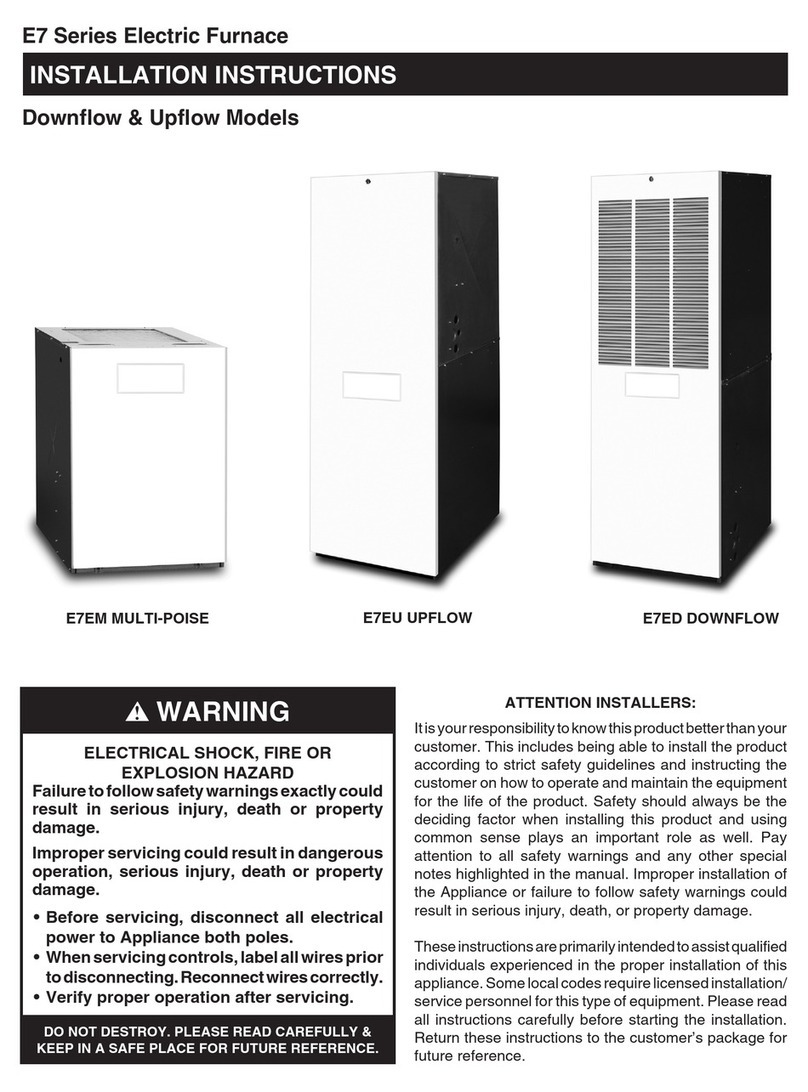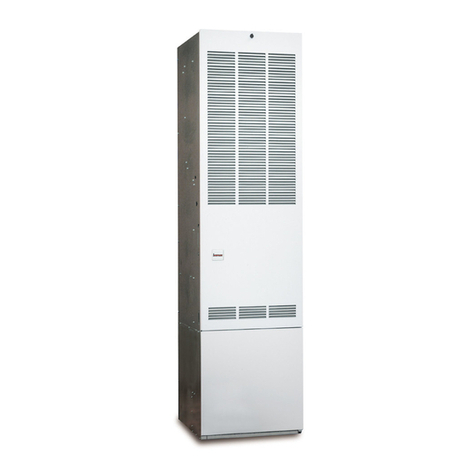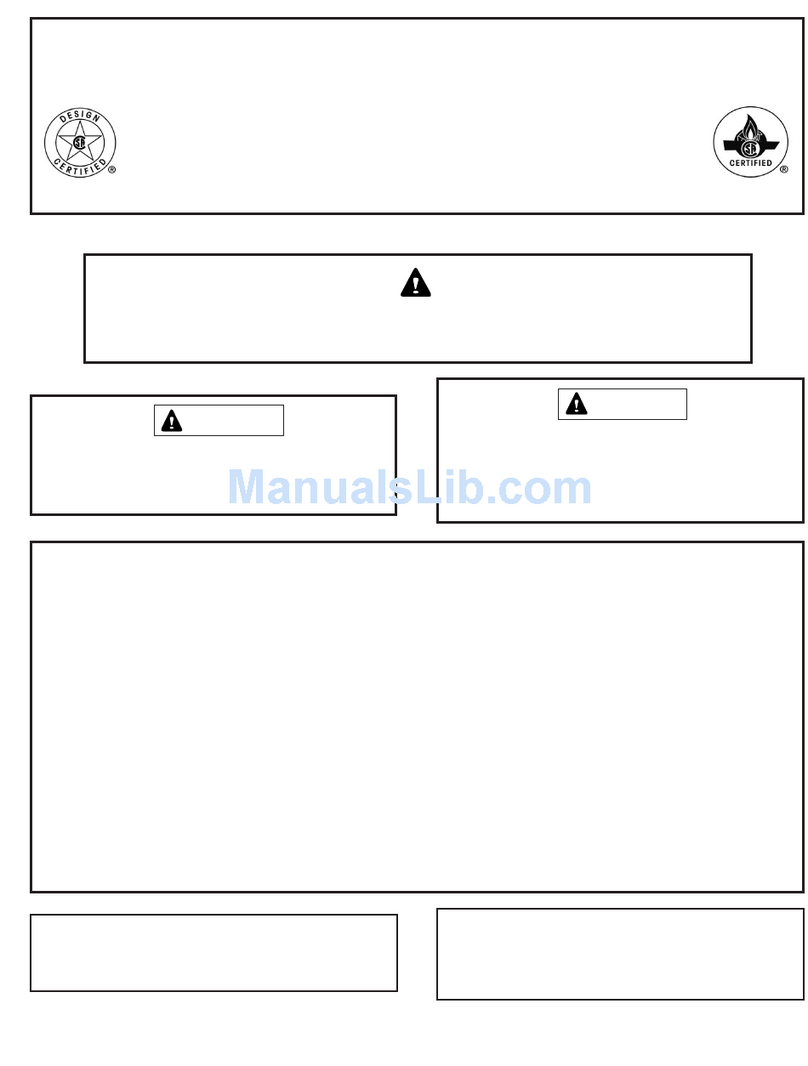Mestek TUBULAR INDOOR GAS-FIRED DUCT FURNACE Troubleshooting guide

TDII-1
J30-09349
01/14
APPROVED FOR USE IN CALIFORNIA
260 NORTH ELM ST., WESTFIELD, MA 01085
TEL: (413) 568-9571 FAX: (413) 562-8437
www.mestek.com
INSTALLATION INSTRUCTIONS AND SERVICE MANUAL
TUBULAR INDOOR GAS-FIRED DUCT FURNACE
ATTENTION: READTHIS MANUAL AND ALL LABELS ATTACHED TO THE UNIT CAREFULLY BEFORE ATTEMPTING
TO INSTALL, OPERATE, OR SERVICE THESE UNITS! CHECK UNIT DATA PLATE FOR TYPE OF GAS AND
ELECTRICAL SPECIFICATIONS AND MAKE CERTAIN THAT THESE AGREE WITH THOSE AT THE POINT OF
INSTALLATION. RECORDTHE UNIT MODEL AND SERIAL No.(s) INTHE SPACE PROVIDED. RETAIN FOR FUTURE
REFERENCE.
Unit No. Serial No.
FORYOUR SAFETY
The use and storage of gasoline or other flammable vapors and liquids in open containers
in the vicinity of this appliance is hazardous.
FORYOUR SAFETY
If you smell gas:
1. Open windows.
2. Do not touch electrical switches.
3. Extinguish any open flame.
4.Immediately contact your gas supplier.
Improper installation, adjustment, alteration, service, or maintenance
can cause property damage, injury, or death. Read the installation, operating and
maintenance instructions thoroughly before installing or servicing this equipment.
Install, operate, and maintain unit in accordance with the manufacturer’s
instructions to avoid exposure to fuel substances, or substances from incomplete
combustion, which can cause death or serious illness.The state of California
has determined that these substances may cause cancer, birth defects, or other
reproductive harm.
INSTALLER’S RESPONSIBILITY
Installer Please Note: This equipment has been test fired and inspected. It has been
shipped free from defects from our factory. However, shipment and installation
problems such as loose wires, leaks, or loose fasteners may occur. It is the installer’s
responsibility to inspect and correct any problems that may be found.
RECEIVING INSTRUCTIONS
Inspect shipment immediately when
received to determine if any damage
has occurred to the unit during
shipment. After the unit has been
uncrated, check for any visible
damage to the unit. If any damage is
found, the consignee should sign
the bill of lading indicating such
damage and immediately file claim
for damage with the transportation
company.

2
TABLE OF CONTENTS
GENERAL SAFETY INFORMATION
Installation Codes …............................................… 2, 3
Special Precautions ….........................................… 2, 3
Converting SI/Metric Unit Measurements …............… 3
SPECIFICATIONS
Basic Description ….................................................… 2
Dimensional Data …................................................… 4
Performance Data …................................................… 5
INSTALLATION
Locating Units …......................................................… 6
Safety Clearances …................................................… 6
Accessibility Clearances …......................................… 6
Ductwork …..............................................................… 7
Airflow, Combustion Inlet Air Ventilation …...............… 7
Suspension …..........................................................… 8
Conversion of Access Side …..................................… 9
Gas Pipe Sizing …...................................................… 9
Pipe Installation …............................................… 10, 11
ELECTRICAL CONNECTIONS ……....................12-14
VENTING
General Venting Information…..........................…15, 16
Standard Combustion…....................................… 17-19
Separated Combustion…..................................… 20-22
OPERATION
Explanation of Controls….......................................… 25
Start-Up and Shutdown…......................................… 25
Gas Input Rate…....................................................… 26
High Altitude Deration…....................................…26, 27
MAINTENANCE …................................................… 28
IDENTIFICATION OF PARTS …............................… 29
TROUBLESHOOTING GUIDES …..................… 30-34
WARRANTY …......................................................… 35
UNIT NUMBER DESCRIPTION …........................… 35
EQUIPMENT START-UP SHEET …......................... 36
GENERAL SAFETY INFORMATION
The tubular duct furnace design is certified by ETL for
use with natural and propane (LP) gases.ANSI and NFPA
Standards as well as Canadian installation codes referred
to in this manual are the ones that were applicable at the
time the design was certified.In addition, the tubular duct
furnace may be installed on the downstream side of a
cooling unit, without need of a bypass duct.
The following terms are used throughout this manual, in
addition to ETL requirements, to bring attention to the
presence of potential hazards or to important information
concerning the product:
Indicates an imminently hazardous
situation which,if not avoided,will result in death,
serious injury, or substantial property damage.
Indicates an imminently hazardous
situation which, if not avoided, could result in
death, serious injury, or substantial property
damage.
Indicates an imminently hazardous
situation which, if not avoided, may result in minor
injury or property damage.
NOTICE: Used to notify of special instructions on
installation, operation, or maintenance which are
important to equipment but not related to personal
injury hazards.
DESCRIPTION
The Tubular Indoor Gas-Fired Duct Furnace is a factory
assembled, power vented, and low static pressure type
duct furnace with a low profile cabinet.The duct furnace
can also be easily field converted to separated
combustion.The design is certified by ETL as providing
a minimum of 82% thermal efficiency, and approved for
use in California. Do not alter these units in any way. If
you have any questions after reading this manual,
contact the manufacturer.
BackFront

3
GENERAL SAFETY INFORMATION
Failure to comply with the general
safety information may result in extensive
property damage,sever personal injury,or death.
This product must be installed by
a licensed plumber or gas fitter when installed
within the Commonwealth of Massachusetts.
Installation must be made in accordance with local
codes,or in absence of local codes, with the latest
edition of the National Fuel Gas Code,ANSI Standard
Z223.1 (NFPA 54). All of the ANSI and NFPA Standards
referredtointhese installation instructionsare those that
were applicable at the time the design of this appliance
wascertified.TheANSI Standards are available fromthe
CSAInformation Services,1-800-463-6727,as well asat
www.ansi.org.TheNFPAStandards areavailable fromthe
National Fire Protection Association, 1 Batterymarch
Park, Quincy, MA 02169, as well as at www.nfpa.org.
These duct furnaces are designed for use in airplane
hangarswheninstalledin accordance with current ANSI/
NFPA No.409 and in public garages when installed in
accordancewithcurrentNFPANo.88Aand NFPANo.88B.
If installed in Canada, the installation must conform with
local building codes, or in absence of local building codes,
with CSA-B149.1 “Installation Codes for Natural Gas
Burning Appliances and Equipment” or CSA-B149.2
“Installation Codes for Propane Gas Burning Appliances
and Equipment.” These indoor duct furnaces have been
designed and certified to comply with CSA 2.6.Also see
sections on installation in AIRCRAFT HANGARS and
PUBLIC GARAGES.
Do not alter the duct furnace in any
way or damage to the unit and/or severe personal
injury, or death may occur!
Disconnect all power and gas
supplies before installing or servicing the heater.
If the power disconnect is out of sight, lock it in
the open position and tag it to prevent unexpected
application of power.Failure to do so could result
in fatal electric shock, or severe personal injury.
Ensure that all power sources conform
to the requirements of the unit heater or damage to
the unit will result!
Follow installation instructions CAREFULLY to avoid
creating unsafe conditions.All wiring should be done and
checked by a qualified electrician, using copper wire only.
All external wiring must conform to applicable local codes,
and to the latest edition of the National Electric Code
ANSI/NFPA No. 70.All gas connections should be made
and leak-tested by a suitable qualified individual, per
instructions in this manual.
Also, follow procedures listed on the “Gas Equipment
Start-up”sheet located on the back cover of this manual.
Use only the fuel for which the heater is designed (see
rating plate). Using LP gas in a heater that requires
natural gas, or vice versa, will create the risk of gas leaks,
carbon monoxide poisoning and explosion.
Do not attempt to convert the
heater for use with a fuel other than the one
intended unless using an appropriate conversion
kit provided by the manufacturer.Such conversion
is dangerous and could create unsafe conditions
that result in death, serious personal injury or
property damage.
Make certain that the power source conforms to the
electrical requirements of the heater.
Do not depend upon a thermostat
or other switch as sole means of disconnecting
power when installing or servicing heater. Always
disconnect power at the main circuit breaker as
described above. Failure to do so could result in
fatal electric shock.
Special attention must be given to any grounding
information pertaining to this heater. To prevent the risk
of electrocution, the heater must be securely and
adequately grounded. This should be accomplished by
connecting a grounded conductor between the service
panel and the heater. To ensure a proper ground, the
groundingmeans must be testedbya qualified technician.
Do not insert fingers or foreign objects into the heater or
its combustion air moving device.Do not block or tamper
with the heater in any manner while in operation or just
after it has turned off, as some parts may be hot enough
to cause injury.
This heater is intended for general heating applications
ONLY. It must NOT be used in potentially dangerous
locations such as flammable, explosive, chemical-laden
or wet atmospheres.
In cases in which property damage may result from
malfunction of the heater, a backup system or a
temperature sensitive alarm should be used.
The open end of gas piping systems
being purged shall not be discharged into areas
where there are sources of ignition or into confined
spaces UNLESS precautions are taken as follows: (1)
By ventilation of the space,(2) control of purging rate,
(3) elimination of all hazardous conditions. All
precautions must be taken to perform this operation
in a safe manner!
Unless otherwise specified, the following conversions
may be used for calculating SI unit measurements:
1 foot = 0.305 m
1 inch = 25.4 mm
1 gallon = 3.785 L
1 pound = 0.453 kg
1 psig = 6.894 kPa
1 cubic foot = 0.028 m3
1000 BTU per hour = 0.293 kW
1 inch water column = 0.249 kPa
1000 BTU/Cu.Ft. = 37.5 MJ/m3
Liter/second = CFM x 0.472
Meter/second = FPM ÷ 196.8

4
DIMENSIONAL DATA
Table 1 -Tubular Duct Furnace Dimensions
Figure 1 -Tubular Duct Furnace Dimensions
Unit Capacity 100 150 200 250 300 350 400
Dimensional Data - inches (mm)
“A” Overall Unit Height 10.3 13.7 17 20.2 23.5 26.7 30
(262) (348) (432) (513) (597) (678) (762)
“B” Height to Centerline Flue 7.6 10.5 11.9 6.8 8.4 10 11.6
(193) (267) (302) (173) (213) (254) (295)
“C” Height to Gas Connection 2.5 3.7 5.3 7 7 8.7 10.3
(64) (94) (135) (178) (178) (221) (262)
“D” Opening Height, Front & Rear 8.5 11.7 15 18.2 21.5 24.7 28
(216) (297) (381) (462) (546) (627) (711)
“E” Overall Unit Depth 32.7 32.7 32.7 33.5 33.5 33.5 33.5
(831) (831) (831) (851) (851) (851) (851)
“F” Flue Size Diameter 5556666
(127) (127) (127) (152) (152) (152) (152)
“G” Air Inlet Size Diameter 5556666
(127) (127) (127) (152) (152) (152) (152)
Gas Inlet, Natural Gas - inch 1/2 1/2 1/2 3/4 3/4 3/4 3/4
Gas Inlet, LP Gas - inch 1/2 1/2 1/2 3/4 3/4 3/4 3/4
Approximate Unit Weight - lb 160 221 250 270 296 321 355
(kg) (73) (100) (113) (122) (134) (146) (161)
Approximate Ship Weight - lb 270 331 360 403 429 454 488
(kg) (122) (150) (163) (183) (195) (206) (221)
65.500
16.5
HANGING
LOCATION
48.7
OPENING
FRONT & REAR
D
OPENING
FRONT & REAR
E
47.50
15.251
30.500 27.50
1.50
C
4
7.197
G
D9362
10.3
1.5
1.5
GAS
CONNECTION
1.000
32.5
PEEP
HOLE
A
F
REAR VIEW
TOP VIEW
SIDE VIEW
B
POWER
CONNECTION
ACCESS PANEL
D9362

5
PERFORMANCE DATA
Table 2 -Tubular Duct Furnace Performance Data
INPUT OUTPUT
(Max.) (Min.) Min. Temp. Rise P.D. Max. Temp. Rise P.D.
UNIT MBH MBH MBH CFM Deg. F in.W.C. CFM Deg. F in.W.C.
SIZE (kW) (kW) (kW) (cu. m/s) (Deg. C) (kPa) (cu. m/s) Deg. C (kPa)
100 100 50 82 758 100 0.07 2528 30 0.65
(29.3) (14.6) (24.0) (0.357) (56) (0.017) (1.193) (17) (0.16)
150 150 75 123 1137 100 0.03 3792 30 0.44
(43.9) (21.9) (36.0) (0.536) (56) (0.007) (1.789) (17) (0.11)
200 200 100 164 1517 100 0.04 5057 30 0.54
(58.6) (29.3) (48.0) (0.715) (56) (0.009) (2.386) (17) (0.13)
250 250 125 205 1896 100 0.08 6321 30 0.76
(73.2) (36.6) (60.0) (0.894) (56) (0.019) (2.983) (17) (0.19)
300 300 150 246 2275 100 0.03 7585 30 0.69
(87.8) (43.9) (72.0) (1.074) (56) (0.007) (3.579) (17) (0.16)
350 350 175 287 2654 100 0.07 8849 30 0.76
(102.5) (51.2) (84.1) (1.252) (56) (0.017) (4.176) (17) (0.19)
400 400 200 328 3034 100 0.08 10,114 30 0.70
(117.1) (58.6) (96.1) (1.431) (56) (0.019) (4.773) (17) (0.17)
Ratings are shown for unit installations at elevations between 0 and 2,000 feet (610m).For unit installations in U.S.A. above 2,000 feet
(610m), the unit input must be field derated 4% for each 1,000 feet (305m) above sea level;refer to local codes, or in absence of local codes,
refer to the latest edition of the National Fuel Gas Code, ANSI Standard Z223.1 (NFPA 54). For installations in Canada, any references to
deration at altitudes in excess of 2,000 feet (610m) are to be ignored. At altitudes of 2,000 to 4,500 feet (610 to 1372m), the unit must be field
derated and be so marked in accordance with the ETL certification. See Table 7A for U.S.A. and Canadian field deration information.
Figure 2
Size 200
Size 250
Size 300
Size 350
Size 400
Size 150
Size 100
0
25
50
75
100
125
150
175
200
225
250
275
300
012345
0
0.2
0.4
0.6
0.8
1
1.2
1.4
Pa
m3/s
Pressure Drop, inches W.C.
Temperature Rise and Pressure Drop Graph
Size 150 Size 200 Size 250 Size 300 Size 350 Size 400
Size 100
6
11
16
21
26
31
36
41
46
51
56
10
20
30
40
50
60
70
80
90
100
0 2000 4000 6000 8000 10000
°C
Temperature Rise, °F
Airflow (CFM)

6
INSTALLATION
LOCATING UNITS
Do not install duct furnaces in
corrosive or flammable atmospheres! Premature
failure of,or severe damage to the unit will result!
Avoid locations where extreme drafts
can affect burner operation. Duct furnaces must not
be installed in locations where air for combustion
would contain chlorinated, halogenated, or acidic
vapors. If located in such an environment,premature
failure of the unit will occur!
NOTICE: Location of duct furnaces is related directly
to the selection of sizes. Basic rules are as follows:
CLEARANCES
Under no circumstances should
combustible material be located within the
clearances specified inTable 3.Failure to provide
proper clearance could result in personal injury
or equipment damage from fire.
Maintain adequate clearances around air openings into
the combustion chamber:
Table 3 - Minimum Safety Clearances*
Sides 6 inches (152mm)
Top 6 inches (152mm)
Bottom 6 inches (152mm)
Flue 6 inches (152mm)
* When clearances required for accessibility are greater than the
minimum safety clearances, the accessibility clearances take
precedence.
ACCESSIBILITY CLEARANCE: the duct furnace must
have 18 inches (457mm) clearance on the control cabinet
end.Provision should alsobe made toassure accessibility
for recurrent maintenance purposes.
ATMOSPHERIC CONSIDERATIONS: Atmospheres
containing commercial solvents or chlorinated
hydrocarbons will produce corrosive acids when coming
in contact with the flames. This will greatly reduce the life
of the gas duct furnace and may void the warranty. Avoid
such areas.
NOTICE: If the gas duct furnace is to be used in
a building classified as having a hazardous
atmosphere, the installation must comply with
the standards set by the National Board of Fire
Underwriters. Consult the authorities having
jurisdiction before starting the job.
The duct furnace must be installed on the positive
pressure side of the air circulation blower.
AIRCRAFT HANGARS: In aircraft hangars, duct
furnaces must be at least 10 feet (3.05m) above the upper
surface of wings or engine enclosures of the highest
aircraft to be stored in the hangar and 8 feet (2.4m) above
the floor in shops, offices, and other sections of the
hangar where aircraft are not stored and housed. Refer
to current ANSI/NFPA No. 409, Aircraft Hangars. In
Canada, installation is suitable in aircraft hangars when
acceptable to the enforcing authorities.
PUBLIC GARAGES: In repair garages, duct furnaces
must be installed in a detached building or room
separated from repair areas as specified in the latest
edition of NFPA 88B, Repair Garages.
In parking structures, duct furnaces must be installed so
that the burner flamesare located a minimum of18 inches
(457mm) above the floor or protected by a partition not
less than 18 inches (457mm) high. Refer to the latest
edition of NFPA 88A, Parking Structures.
In Canada, installation must be in accordance with the
latest edition of CSA B149 “Installation Codes for Gas
Burning Appliances and Equipment.”
NOTICE: The duct furnace must be installed such
that the gas ignition control system is not directly
exposed to water spray, rain, or dripping water.
Duct furnaces should not be installed to maintain low
temperatures and/or freeze protection of buildings.
A minimum of 50°F (10°C) thermostat setting must
be maintained. If duct furnaces are operated to maintain
lower than 50°F (10°C), hot flue gases are cooled inside
the heat exchanger to the point where water vapor (a flue
gas byproduct) condenses onto the heat exchanger walls.
The result is a mildly corrosive acid that prematurely
corrodes the aluminized steel heat exchanger and can
actually drip water down from the duct furnace onto the
floor surface below. Additional duct furnaces should be
installed if a minimum 50°F (10°C) thermostat setting
cannot be maintained.

7
INSTALLATION (continued)
DUCTWORK
Properly designed and installed ductwork, providing a
uniformly distributed flow of air across all surfaces of the
heat exchanger, is essential to satisfactory unit
performance and life of the equipment.
All duct connection flanges/seams must be sealed to
prevent air leaks. Sealant/tape must be suitable for
temperatures of 250°F (121°C) minimum.
Any attempts to straighten the 90°
duct connection flanges on the duct furnaces will
affect the operation of the furnace and will void
the warranty.
If uniform air distribution is not obtained, install additional
baffles and/or turning vanes in the ductwork.
Figures 3 and4 illustrate recommendedductwork designs
for both the straight-through and elbowed air inlet
arrangements.
Access panels large enough to observe smoke and
reflected light, and to detect the presence of leaks in the
heating equipment, are required both upstream and
downstream from gas duct furnaces.These panels must
be sealed to prevent air leaks. If allowed by local
regulations, install canvas connectors between the
ductwork and fan discharge opening to eliminate the
transmission of mechanical vibration.
AIR FLOW
The installation is to be adjusted to obtain an air
throughput within the range specified on the appliance
rating plate.
COMBUSTION INLET AIRVENTILATION
Inlet Air From Another Room – If the duct furnace is
installed in a separate room or compartment, provide two
inlet air openings.The size of each vent opening should
benolessthanonesquareinch(6.452squarecentimeters)
of free area for each 1000 Btu/hr. (293 W) input. Each
opening must not be less than 100 square inches (645
square centimeters).
Inlet Air From Outdoors – If the enclosed space is
to have inlet combustion air from the outside, the vent
opening should be no less than one square inch
(6.452 square centimeters) of free area for each
2500-3000 Btu/hr.(733-879W) input.Each opening must
not be less than 100 square inches (645 square
centimeters).
BYPASS
When a gas duct furnace is installed to operate in
conjunction with a summer air conditioning system, the
CFM air delivery of the system blower should be adjusted
to meet the design air volume requirements for cooling.
If this CFM delivery is greater than that required for
heating, resulting in a low air temperature rise, install a
damper bypass around the gas duct furnace to bypass a
portion of the air.
Figure 3 - Recommended Ductwork Design for
Straight-Through Arrangement
Figure 4 - Recommended Ductwork Design
for Elbowed Arrangement
D9382
D9381

8
INSTALLATION (continued)
SUSPENSION
Figure 5 -Typical Suspension
Ensure that all hardware used in
the suspension of each duct furnace is more than
adequate for the job. Failure to do so may result
in extensive property damage, personal injury or
death.
The duct furnace must be hung level
from side to side and front to back, from four
suspension points provided at the top of the unit.
Failure to do so will result in poor performance and/
or premature failure of the unit. Refer to Figure 5 for
typical suspension. DO NOT mount duct furnaces in
series (one in front of another).
NOTICE: Minimum safety clearances must also be
maintained; seeTable 3.When service/accessibility
clearances are greater than minimum safety
clearances, service/accessibility clearances take
precedence. See “Clearances” section under
“Installation.”
Make certain that the lifting
methods used to lift the duct furnace are capable
of supporting the weight of the heater during
installation. Failure to heed this warning may
result in property damage or personal injury.See
Table 1 for unit weights.
Make certain that the structure to
which the duct furnace is to be mounted is
capable of safely supporting its weight. Under
no circumstances must the gas lines, venting
system, or the electrical conduit be used
to support the duct furnace or any other objects
(i.e. ladder, person) lean against the gas lines,
venting system,or electrical conduit for support.
Failure to heed these warnings may result in
property damage, personal injury, or death.
SECTION A-A
SCALE 1:1
A
A
D9376
AIRFLOW
←
3/8" THREADED SUSPENSION ROD
& JAM NUT BY INSTALLER
OUTSIDE JACKET
PANEL (UNIT)
D9376

9
INSTALLATION (continued)
CONVERSION OF ACCESS SIDE
The tubular duct furnace is built and shipped as left side
access – when looking in the direction of airflow, gas and
flue connections, control cabinet access are on the left
hand side and the combustion air inlet is on top. When
looking in the direction of airflow, you will be facing the
entering air side of the duct furnace.To convert the unit
to right side access:
1. Before suspending unit, flip the duct furnace 180
degrees widthwise (not rotated) so the gas and flue
connections are still on the entering air side of the
duct furnace.
2. Remove the four (4) screws holding the combustion
air inlet screen (now located on the bottom of the
unit);the screen and gasket can be removed and set
aside.
3. Removethe four (4) screws holding the block-offplate
(now located on the top of the unit);the plate and the
gasket can be removed and set aside.
4. Reinstall the block-off plate and its gasket on the
bottom of the unit using the four (4) screws.
5. Reinstall the combustion air inlet screen and its
gasket on the top of the unit using the four (4) screws.
It is not required to switch the combustion air inlet screen
and block-off plate locations once the unit has been
flipped. However, due to combustion noise, it is
recommended to keep the air inlet screen on top for
overhead installations.
NOTICE: If unit access side is converted, ensure
accessibility clearance is taken into account for the
new control cabinet end of the unit before suspension/
installation.
GAS PIPE SIZING
To avoid damage or possible
personal injury,do not connect gas piping to this
unit until a supply line pressure/leak test has been
completed.Connecting the unit before completing
the pressure/leak test may damage the unit gas
valve and result in a fire hazard.
Do not rely on a shut-off valve to
isolate the unit while conducting gas pressure/
leak tests. These valves may not be completely
shut off, exposing the gas valve to excessive
pressure and damage.
PIPE SIZING
To provide adequate gas pressure to the gas unit heater,
size the gas piping as follows:
1. Find the cu. feet/hr. by using the following formula:
Cu. ft./hr. = Input BTU/Hr.
1000
2. Refer to Table 4.Match “Length of Pipe in Feet” with
appropriate “Gas Input - Cu.Ft./Hr.”figure.This figure
can then be matched to the pipe size at the top of the
column.
Example:
It is determined that a 67 foot (20.4m) run of gas pipe
is required to connect a 200 MBTU gas unit heater
to a 1,000 BTU/cu feet (0.29kW) natural gas supply.
200,000 BTU/Hr. = 200 Cu. ft./hr.
1,000 BTU/cu. feet
Using Table 4, a 1 inch pipe is needed.
NOTE: See General Safety Information section for
English/Metric unit conversion factors.
NOTICE: If more than one unit heater is to be served
by the same piping arrangement, the total cu. ft./hr.
input and length of pipe must be considered.
NOTICE: If the gas unit heater is to be fired with LP
gas, consult your local LP gas dealer for pipe size
information.
NOTICE: HEATER INSTALLATION FOR USE WITH
PROPANE (BOTTLED) GAS MUST BE MADE BY
A QUALIFIED L.P. GAS DEALER OR INSTALLER.
HE/SHE WILL INSURE THAT PROPER JOINT
COMPOUNDS ARE USED FOR MAKING PIPE
CONNECTIONS;THAT AIR IS PURGED FROM LINES;
THAT A THOROUGH TEST IS MADE FOR LEAKS
BEFORE OPERATINGTHE HEATER; ANDTHAT IT IS
PROPERLY CONNECTEDTOTHE PROPANE GAS
SUPPLY SYSTEM.
Before any connection is made to the existing line
supplying other gas appliances, contact the local gas
company to make sure that the existing line is of adequate
size to handle the combined load.

10
INSTALLATION (continued)
PIPE INSTALLATION
1. Install the gas piping in accordance with applicable
local codes.
2. Check gas supply pressure.Each duct furnace must
be connectedto a manifold pressure and agas supply
capable of supplying its full rated capacity as
specified inTable 5.A field LP tank regulator must be
used to limit the supply pressure to a maximum of 14
inches W.C. (3.5 kPa). All piping should be sized in
accordance with the latest edition of ANSI Standard
Z223.1 (NFPA 54), National Fuel Gas Code; in
Canada, according to CSA B149. See Tables 1 & 4
for correctgas piping size.If gas pressureis excessive
on natural gas applications, install a pressure
regulating valve in the line upstream from the main
shutoff valve.
3. Adequately support the piping to prevent strain on
the gas manifold and controls.
4. To prevent the mixing of moisture with gas, run the
take-off piping from the top, or side, of the main.
5. Standard duct furnaces, optional two-stage and
modulation units are supplied with a combination
valve which includes:
a. Manual “A” valve
b. Manual “B” valve
c. Solenoid valve
d. Pressure regulator
Pipe directly into the combination valve (see Figure 6).
6. Gas valve has a pressure test post requiring a
3/32 inch hex head wrench to read gas supply and
manifold pressures.Open 1/4 turn counterclockwise
to read, turn clockwise to close and reseat. A
5/16 inch ID hose fits the pressure post.
7. Provide a drip leg in the gas piping near the gas duct
furnace. A ground joint union and a manual gas
shutoff valve should be installed ahead of the unit
heater controls to permit servicing. The manual
shutoff valve must be located external to the jacket
(See Figure 6).
8. Make certain that all connections have been
adequately doped and tightened.
Do not over tighten the inlet gas piping
into the valve.This may cause stresses that will crack
the valve!
NOTICE: Use pipe joint sealant resistant to the action
of liquefied petroleum gases regardless of gas
connected.
Check all pipe joints for leakage
using a soap solution or other approved method.
Never use an open flame or severe personal injury
or death may occur!
1. Determine the required Cu. Ft./Hr. by dividing the input by 1000.For SI/Metric measurements:Convert BTU/Hr. to kilowatts.Multiply the units
inputs (kW) by 0.0965 to determine Cu. Meters./Hr. 2. FOR NATURAL GAS: Select pipe size directly from the table.3. FOR PROPANE GAS:
Multiply the Cu. Ft./Hr. value by 0.633; then, use the table. 4. Refer to the metric conversion factors listed in the General Safety section for SI Unit
measurement conversions.
Maximum Capacity of Pipe in Cubic Feet of Gas per Hour (Cubic Meters per Hour) for Gas Pressures of 0.5 psig (3.5 kPa) or Less,
and a Pressure Drop of 0.5 Inch Water Column (124.4 Pa)
(Based on a 0.60 Specific Gravity Gas)
Nominal
Iron Internal
Length of Pipe, Feet (meters)
Pipe Size Diameter
10 20 30 40 50 60 70 80 90 100 125 150 175 200
Inch Inch
(3.0) (6.1) (9.1) (12.2) (15.2) (18.3) (21.3) (24.4) (27.4) (30.5) (38.1) (45.7) (53.3) (61.0)
1/2 0.622 175 120 97 82 73 66 61 57 53 50 44 40 37 35
(4.96) (3.40) (2.75) (2.32) (2.07) (1.87) (1.73) (1.61) (1.50) (1.42) (1.25) (1.13) (1.05) (0.99)
3/4 0.824 360 250 200 170 151 138 125 118 110 103 93 84 77 72
(10.2) (7.08) (5.66) (4.81) (4.28) (3.91) (3.54) (3.34) (3.11) (2.92) (2.63) (2.38) (2.18) (2.04)
1 1.049 680 465 375 320 285 260 240 220 205 195 175 160 145 135
(19.3) (13.2) (10.6) (9.06) (8.07) (7.36) (6.80) (6.23) (5.80) (5.52) (4.96) (4.53) (4.11) (3.82)
1 1/4 1.380 1400 950 770 660 580 530 490 460 430 400 360 325 300 280
(39.6) (26.9) (21.8) (18.7) (16.4) (15.0) (13.9) (13.0) (12.2) (11.3) (10.2) (9.20) (8.50) (7.93)
1 1/2 1.610 2100 1460 1180 990 900 810 750 690 650 620 550 500 460 430
(59.5) (41.3) (33.4) (28.0) (25.5) (22.9) (21.2) (19.5) (18.4) (17.6) (15.6) (14.2) (13.0) (12.2)
2 2.067 3950 2750 2200 1900 1680 1520 1400 1300 1220 1150 1020 950 850 800
(112) (77.9) (62.3) (53.8) (47.6) (43.0) (39.6) (36.8) (34.5) (32.6) (28.9) (26.9) (24.1) (22.7)
2 1/2 2.469 6300 4350 3520 3000 2650 2400 2250 2050 1950 1850 1650 1500 1370 1280
(178) (123) (99.7) (85.0) (75.0) (68.0) (63.7) (58.0) (55.2) (52.4) (46.7) (42.5) (38.8) (36.2)
3 3.068 11000 7700 6250 5300 4750 4300 3900 3700 3450 3250 2950 2650 2450 2280
(311) (218) (177) (150) (135) (122) (110) (105) (97.7) (92.0) (83.5) (75.0) (69.4) (64.6)
4 4.026 23000 15800 12800 10900 9700 8800 8100 7500 7200 6700 6000 5500 5000 4600
(651) (447) (362) (309) (275) (249) (229) (212) (204) (190) (170) (156) (142) (130)
Table 4 - Gas Pipe Size

11
INSTALLATION (continued)
Figure 6 - Pipe Installation, Standard Controls
Never use an open flame to detect
gas leaks. Explosive conditions may exist which
may result in personal injury or death!
The appliance and its individual shutoff valve must be
disconnected from the gas supply piping system during
any pressure testing of that system in excess of 1/2 psig
(3.5 kPa).
The appliance must be isolated from thegas supply piping
system by closing its individual manual shutoff valve
during any pressure testing of the gas supply piping
system at test pressures equal to or less than 1/2 psig
(3.5 kPa).
Table 5 - Gas Supply Pressure*
Natural Gas Propane Gas
Heating Value 1,050 BTU/Ft3
(39.1 MJ/m3)2,500 BTU/Ft3
(93.1 MJ/m3)
Manifold Pressure
Single Stage
Application (inch WC)
(kPa) 3.5
(0.87) 10.0
(2.49)
Two Stage
Application -
High Fire
(inch WC)
(kPa) 3.5
(0.87) 10.0
(2.49)
Two Stage
Application -
Low Fire
(inch WC)
(kPa) 1.1
(0.27) 3.8
(0.95)
Modulating
Application -
High Fire
(inch WC)
(kPa) 3.5
(0.87) 10.0
(2.49)
Modulating
Application -
Low Fire
(inch WC)
(kPa) 0.9
(0.22) 3.5
(0.87)
Minimum Supply Pressure
Single Stage
Application (inch WC)
(kPa) 5.0
(1.24) 11.0
(2.74)
Two Stage
Application (inch WC)
(kPa) 6.5
(1.62) 11.5
(2.86)
Modulating
Application (inch WC)
(kPa) 6.5
(1.62) 11.5
(2.86)
Maximum
Supply
Pressure
(inch WC)
(kPa) 14.0
(3.49) 14.0
(3.49)
* Applicable for units installed at or below 2,000 feet (610m) altitude.
See High Altitude Deration information for altitudes greater than
2,000 feet (610m).
D3631C

12
ELECTRICAL CONNECTIONS
HAZARDOUSVOLTAGE!
DISCONNECT ALL ELECTRIC
POWER INCLUDING REMOTE
DISCONNECTS BEFORE
SERVICING. Failure to
disconnect power before
servicing can cause severe
personal injury or death.
Standard units are shipped for use on 115 volt, 60 hertz,
single phase electric power.The duct furnace data plate
and electrical rating of the transformer should be checked
before energizing the duct furnace electrical system. All
external wiring must conform to the latest edition of ANSI/
NFPA No.70, United States National Electrical Code, and
applicable local codes; in Canada, to the Canadian
Electrical Code, Part 1, CSA Standard C22.1.
Do not use any tools (i.e. screwdriver,
pliers,etc.) across terminals to check for power. Use
a voltmeter. Failure to do so may result in personal
injury or property damage.
USE COPPER CONDUCTORS ONLY!
UNIT TERMINALS ARE NOT DESIGNEDTO ACCEPT
OTHER TYPES OF CONDUCTORS. Failure to do so
may cause damage to the equipment.
It is recommendedthat the electrical power supplyto each
duct furnace be provided by a separate, fused, and
permanently live electrical circuit.A disconnect switch of
suitable electrical rating should be located as close to the
gas valve and controls as possible. Each duct furnace
must be electrically grounded in accordance with the
latest edition of the United States National Electrical
Code, ANSI/NFPA No.70, or CSA Standard C22.1.Refer
to Figures 7a, 7b, 7c, 7d, 7e, 7f, and 7g.
THERMOSTAT WIRING AND LOCATION:
NOTICE: The thermostat must be mounted on a
vertical, vibration-free surface,free from air currents,
and in accordance with the furnished instructions.
Mount the thermostat approximately 5 feet (1.5m) above
the floor, in an area where it will be exposed to a free
circulation of average temperature air.Always refer to the
thermostat instructions, as well as the duct furnace wiring
diagram, and wire accordingly. Avoid mounting the
thermostat in the following locations:
1. Cold Areas – Outside walls or areas where drafts
may affect the operation of the control.
2. Hot Areas – Areas where the sun’s rays, radiation,
or warm air currents may affect the operation of the
control.
3. Dead Areas – Areas where the air cannot circulate
freely, such as behind doors or in corners.
Figure 7a -
Low-voltage
ThermostatWiring
Single Stage
Figure 7b -
Low-voltage
ThermostatWiring
Two Stage
Figure 7c -
Low-voltage
T834H,T834N
(or equivalent)
ThermostatWiring
Single Stage
NOTICE:The start-up fan delay should not exceed 30
seconds from a cold start.
IMPORTANT: For all wiring connections, refer to the
wiring diagram shipped with your unit (either affixed
to the inside of the control access panel or enclosed
in the installation instructions envelope). Should any
original wire supplied with the unit have to be
replaced including high limit wires, it must be
replaced with wiring material having a temperature
rating of at least 105°C.
Standard single stage and optional two stage wiring
diagrams are included in this manual. Duct furnaces
equipped with modulating gas controls and other optional
equipment will be shipped with a unit-specific wiring
diagram.
D6922C
D8541
D4788

13
ELECTRICAL CONNECTIONS (continued)
Figure 7d –Tubular Duct Furnaces Equipped with Natural Gas or Propane (LP) Gas, Single Stage

14
ELECTRICAL CONNECTIONS (continued)
Figure 7e -Tubular Duct Furnaces Equipped with Natural Gas or Propane (LP) Gas,Two Stage

15
VENTING
NOTICE: All vertical and horizontal venting arrangements forTubular Duct Furnaces are Category III venting.
ANSI now organizes vented appli-
ances into four categories. Category I
Includes non-condensing appliances
with negative vent pressure, like the
traditional atmospheric unit heater.
Category II
Groups condensing appliances with
negative vent pressure.
Venting Categories
Non
Condensing Condensing
Negative
Vent I II
Pressure
Positive
Vent III IV
Pressure
All duct furnaces must be vented! All venting installations shall be in accordance with the latest edition of Part 7,
Venting of Equipment of the National Fuel Gas Code, ANSI Z223.1 (NFPA 54), or applicable provisions of local
building codes. Refer to Figures 8A, 8B, 9A, 9B, 10A, 10B, 11A, and 11B. For installations in Canada, see page 16.
CARBON MONOXIDE!Your venting system must not be blocked by any snow, snow drifts,
or any foreign matter. Inspect your venting system to ensure adequate ventilation exists at all times!
Failure to heed these warnings could result in Carbon Monoxide Poisoning (symptoms include grogginess,
lethargy, inappropriate tiredness, or flu-like symptoms).
Do not damper or add heat recovery devices to the flue piping.Failure to open such a damper prior to operating gas
unit will result in the spillage of flue gas into the occupied space.
Category III
Appliances are non-condensing and
operate with a positive vent pressure.
Category IV
Covers condensing appliances with
positive vent pressure.
VENTING FOR POWER VENTED DUCT FURNACES (CATEGORY III)
Maintain 6 inch (152mm) between vent pipe and
combustible materials. A minimum of 12 inch (305mm)
of straight pipe is required from the venter outlet before
installing an elbow in the vent system.An elbow should
never be attached directly to the venter!
Never use a pipe of a diameter
other than that specified in Table 1! Never use
PVC or other nonmetallic pipe for venting!To do
so may result in serious damage to the unit,
severe personal injury, or death.
Any run of single wall vent pipe exposed to cold air or
passing through an unheated space must be insulated
with insulation suitable to 550°F (288°C).
The vent system must be installed to prevent collection
of condensate. Vertical vent pipes should be equipped
with condensate drains.Pitch horizontal pipes downward
1/4 inch per foot (21mm/m) toward outlet for condensate
drainage.
ALL DUCT FURNACES MUST BEVENTED! All venting
installations shall be in accordance with the latest edition
of Part 7, Venting of Equipment of the National Fuel Gas
Code, ANSI Z223.1, or applicable provisions of local
building codes for power vented units. Also see page 16
for additional Canadian installation information.
Vent pipe material must be in compliance with UL 1738
for installations in the United States, and UL S636 for
installations in Canada.
Refer toTable 6 for vent termination clearance require-
ments.
Through the wall vents for these appliances shall NOT
terminate over public walkways, or over an area where
condensate or vapor could create a nuisance or hazard
or could be detrimental to the operation of regulators,
relief valves, or other equipment.
The vent pipe equivalent length must be 5 feet (1.5m)
minimum andmust notexceed50 feet(15.2m).Equivalent
length is the total length of straight sections PLUS 10 feet
(3.05m) for each 90 degree elbow, and 4 feet (1.22m) for
each 45 degree elbow.

16
VENTING (continued)
VENTING FOR POWER VENTED DUCT FURNACES (CATEGORY III) (continued)
Horizontal portions of the venting system shall be
supported at maximum intervals of 4 feet (1.2m) to
prevent sagging. In Canada, support at a maximum of
3 feet (1m) intervals.
Each unit must have an individual vent pipe and vent
terminal per furnace section! Each unit MUST NOT be
connected to other vent systems or to a chimney.
Vent Systems Termination Clearance Requirements
Structure/Object Minimum Clearance forTermination Locations
USA CANADA
Door, window, or gravity vent inlet; combustion
air inlet for other appliances 9 inch for 10,000 to 50,000 BTU/Hr input;
12 inch for input exceeding 50,000 BTU/Hr. 9 inch (230mm) for 10,000 to 50,000 BTU/Hr input;
12 inch (305mm) for input exceeding 50,000 BTU/Hr.
Forced air inlet within 10 feet
3 feet above 6 feet (1.8m)
Adjoining Building or parapet 10 feet 10 feet (3.04m)
Adjacent public walkways 7 feet above grade 7 feet (2.1m) above grade
Electric, gas meters & regulators 4 feet horizontal 3 feet (0.9m) horizontally from meter/regulator
asembly. 6 feet (1.8m), any direction, from a gas
service regulator vent outlet
Above grade level* 1 foot 1 foot (0.3m)
*Minimum above maximum snow depth, or per local code, whichever is greater.
ADDITIONAL REQUIREMENTS FOR CANADIAN INSTALLATIONS
REFER TO SPECIFICATION TABLE AND INSTALLATION MANUAL FOR PROPER USAGE
The following instructions apply to Canadian installations in addition to installation and operating instructions.
1. Installation must conform with local building codes, or in the absence of local codes, with current CSA-B149.1, Installation Codes for Natural
Gas Burning Appliances and Equipment, or CSA-B149.2, Installation Codes for Propane Gas Burning Appliances and Equipment.
2. Any reference to U.S.standards or codes in these instructions are to be ignored, and the applicable Canadian standards or codes applied.
Table 6

17
VENTING (continued)
VERTICALLYVENTED DUCT FURNACES (CATEGORY III)
Observe the following precautions when venting the unit:
1. Use flue pipe of the same size as the flue connections
on the gas duct furnace (See Table 1). All heaters
should be vented with UL Listed (UL 1738 in United
States, UL S636 in Canada) double wall or single wall
vent pipe, a factory built chimney, or a lined brick and
mortar chimney that has been constructed in
accordance with the National Building Code.
2. Provide as long a vertical run of flue pipe at the duct
furnace as possible. A minimum of 5 feet (1.5m) of
vertical flue is required. The top of the vent pipe
should extend at least 2 feet (0.61m) above the
highest point on the roof. Install a weather cap over
the vent opening;cap should be a BreidertType L or
Fields Starkap vent cap. Consideration should be
made for anticipated snow depth.See Figure 8A.
3. Slope horizontal runs upward from the duct furnace
at least 1/4 inch per foot (21mm/m) minimum.
Horizontal runs should not exceed 75% of the vertical
height of the vent pipe, or chimney, above the flue
pipe connections, up to a maximum length of 10 feet
(3m). Horizontal portions of the venting system shall
be supported at minimum intervals of 4 feet (1.2m)
in the United States, and at minimum intervals of
3 feet (1m) in Canada. See Figure 8A.
4. Use as few elbows as possible.
5. Avoid running vent pipe through unheated spaces.
6. When this cannot be avoided, insulate the pipe to
prevent condensation of moisture on the walls of the
pipe.
7. Do not damper the flue piping. Failure to open such
damper prior to operating the duct furnace will result
in the spillage of flue gas into the occupied space.
8. Avoid installingunits in areasunder negativepressure
due to large exhaust fans or air conditioning. When
required, a flue vent fan should be installed in
accordance with the instructions included with the
fan.
9. Vent connectors serving Category I and Category II
heaters shall not be connected into any portion of
mechanical draft systems operating under positive
pressure.

18
VENTING (continued)
HORIZONTALLYVENTED DUCT FURNACES (CATEGORY III)
Observe the following precautions when venting the unit:
1. Horizontal venting arrangements are designed to be
used with single wall or double wall vent pipe.
Horizontal venting arrangements must terminate
external to the building using UL 1738 vent pipe in
the United States. For installations in Canada, use
vent pipe conforming with UL S636, local building
codes, or in the absence of local building codes, with
current CSA-B149.1 Installation Codes for Natural
Gas Burning Appliances and Equipment, or
CSA-B149.2 Installation Codes for Propane Gas
Burning Appliances and Equipment.
Do not use Type B (double wall)
vent internally within the building on power
vented units that are vented horizontally.
2. Single wall and double wall venting components
which are UL Listed and approved for Category III
positive pressure venting systems MUST be used.
3. A BreidertType L or Fields Starkap vent cap must be
supplied by the customer for each power vented unit.
Thevent pipediameterMUSTbeas specified inTable
1 (“F” Flue Size Diameter). All unit sizes are factory
equipped with the required flue size collar.
4. The vent terminal mustbe at least 12inches (305mm)
from the exterior of the wall that it passes through
to prevent degradation of the building material by
flue gases. Minimum and maximum wall thickness
for the venting system consist of 4-1/4 inch (105mm)
to 8-1/2 inch (216mm) for 5 inch (127mm) diameter
vent pipe and 5-3/4 inch (146mm) to 11-1/2 inches
(292mm) on 6 inch (152mm) vent pipe.
5. Through the wall vent for these appliances shall NOT
terminate over public walkways, or over an area
where the condensate or vapor could create a
nuisance or hazard, or could be detrimental to the
operation of regulators, relief valves, or other
equipment. See Figure 8B and Table 6 for vent
terminal height and snowconsiderationrequirements.
6. The vent pipe equivalent length must not exceed
50 feet (15.2m). Equivalent length is the total length
of straight sections PLUS 10 feet (3.05m) for each
90 degree elbow and 4 feet (1.22m) for each 45
degree elbow.
7. Maintain clearance between the vent pipe and
combustible materials in accordance with the vent
pipe manufacturer’s instructions.
8. The vent system must be installed to prevent
collection of condensate.Pitch horizontal portions of
vent pipe downward 1/4 inch per foot (21mm/m)
toward the outletforcondensate drainage.See Figure
8B.
9. Horizontal portions of the venting system shall be
supported at maximum intervals of 4 feet (1.2m) in
the United States, and at minimum intervals of 3 feet
(1m) in Canada.
10. Insulate single wall vent pipes exposed to cold air or
running through unheated areas.
11. Each unit must have an individual vent pipe and vent
terminal! Each unit MUST NOT be connectedto other
vent systems or to a chimney.

19
Figure 8A -Vertically Vented Category III, Standard Combustion
VENTING (continued)
Figure 8B - HorizontallyVented Category III, Standard Combustion
D9379B
D9378B
Condensate Drain with Trap
(if requried by local authorites)
Approved Vent
Terminal
5 ft (1.52 m) Min
1FT (305 mm) Min. above grade
plus max. snow depth, or per
local code, whichever is greater.
1 FT. Min
(305 mm) 1/4" per foot Min. Slope
(21mm/m)
2 ft Min.
(0.61 m Min)
5 ft. Min.
(1.52 m Min.)
6" (152 mm) Min.
Distance from pipe
to ceiling
10 ft. Max. (3.05 m)
(Not to Exceed 75%
Vertical Flue Height)
1/4" per foot Min. Slope
(21 mm/m)
Thimble Roof
Use Insulated Stack Outdoors
Approved Vent Terminal

20
VENTING (continued)
NOTICE: Combustion and exhaust venting instructions below describe two-pipe venting of a duct furnace
configured for separated combustion. If converting the duct furnace to separated combustion, an Air Inlet
Kit (X9) is required and instructions included with the kit must be followed to complete the conversion
process.If venting a separated combustion duct furnace concentrically (through one roof or wall termination),
a Combustion Air Inlet Kit (X8) is required and instructions included with the kit should be followed with
regards to vent pipe installation. Both kits are available from the manufacturer.
COMBUSTION AIRVENTING AND PIPING
Never operate separatedcombustion
duct furnaces without combustion air and flue gas
piping in place or severe personal injury or death
may occur!
CARBON MONOXIDE! Your venting
system must not be blocked by any snow, snow
drifts, or any foreign matter. Inspect your venting
system to ensure adequate ventilation exists at all
times! Failure to heed these warnings could result
in Carbon Monoxide Poisoning (symptoms include
grogginess, lethargy, inappropriate tiredness, or
flu-like symptoms).
1. In the United States, the combustion air system
installation must be in accordance with the latest
edition of ANSI Z223.1 (NFPA 54) National Fuel Gas
Code. In Canada, installation must be in accordance
with CSA-B149.1 “Installation Code for Natural Gas
Burning Appliances and Equipment”and CSA-B149.2
“Installation Code for Propane Burning Appliances
and Equipment.”
2. A BreidertType L or Fields Starkap, furnished by the
customer, must be installed at the termination point
of the combustion air system. See Figures 9A and
9B.
3. Each duct furnace MUST have its own combustion
air system. It MUST NOT be connected to other air
intake systems.
4. Use UL 1738 listed single wall pipe for the vent
system. For installations in Canada, use UL S636
listed vent pipe conforming with local building codes,
or in the absence of local building codes, with current
CSA-B149.1 “Installation Codes for Natural Gas
Burning Appliances and Equipment” or CSA-B149.2,
“Installation Codes for Propane Gas Burning
Appliances and Equipment.”
Never use pipe of a diameter other
than that specified inTable 1! Never use PVC,ABS
or any other non-metallic pipe for venting!To do
so may result in serious damage to the unit and/
or severe personal injury or death!
5. Long runsof single wallcombustion airpiping passing
through an unheated space may require insulating if
condensation becomes noticeable.
6. The combustion air system must be installed to
prevent collection of condensate. Pitch horizontal
pipes downward 1/4 inch per foot (21mm/m) toward
the inlet capto facilitate drainage. Vertical combustion
air pipes should be piped as depicted in Figure 9A.
7. The equivalent length of the combustion air system
must not be less than 5 feet (1.5m) and must not
exceed 50 feet (15.2m).Equivalent length equals the
total length of straight pipe, plus 10 feet (3.05m) for
each90°elbowand 4 feet(1.22m) foreach 45° elbow.
NOTICE: For optimum performance keep the
combustion air system as straight as possible.
8. Each slip joint must be secured with at least three
corrosion resistant screws.Two full turns of 3M #425
Aluminum Foil Tape or its equivalent must then be
used to seal each joint. General Electric RTV-108,
Dow-Corning RTV-732 or an equivalent may be used
instead of tape.
9. For horizontal combustion air systems longer than
5 feet (1.5m), the system must be supported from
overheard building structures at 4 feet (1.22m)
maximum intervals in the United States and at 3 feet
(1m) maximum intervals in Canada.
Table of contents
Popular Furnace manuals by other brands
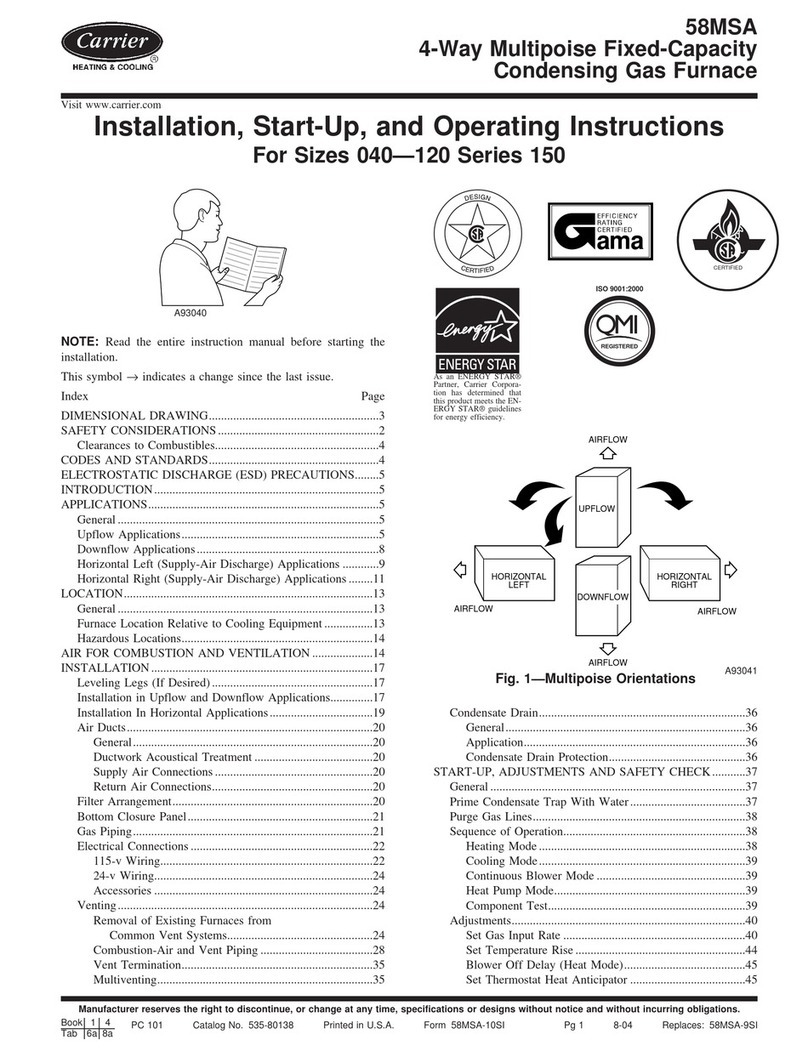
Carrier
Carrier 58MSA Series Installation, start-up, and operating instructions
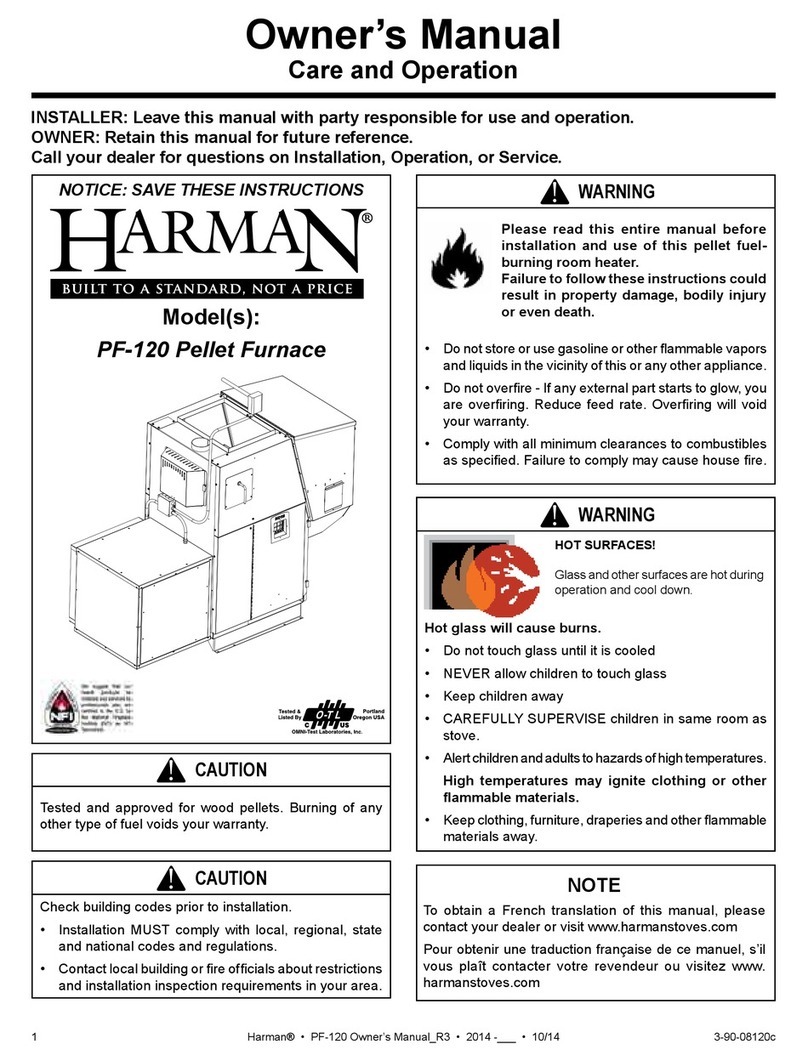
Harman
Harman PF-120 owner's manual
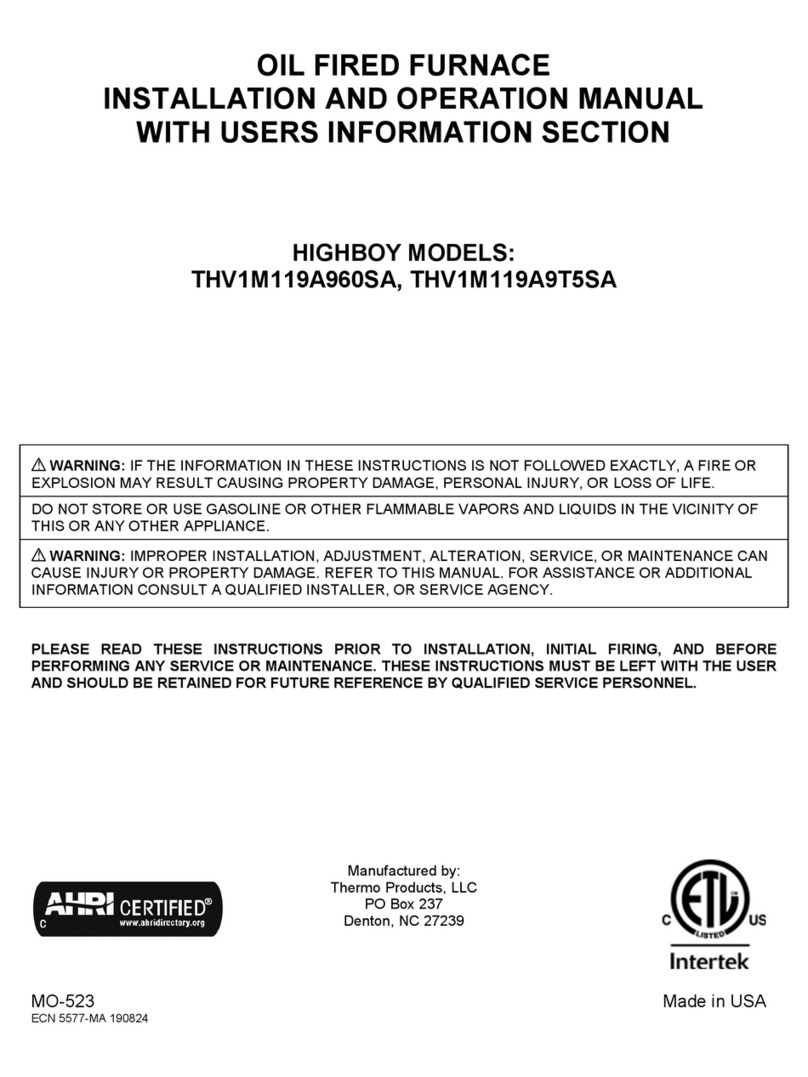
Thermo Products
Thermo Products THV1M119A960SA Installation and operation manual

Lennox
Lennox ML195UH User's information manual

Carrier
Carrier 110 Series Installation, start-up, and operating instructions
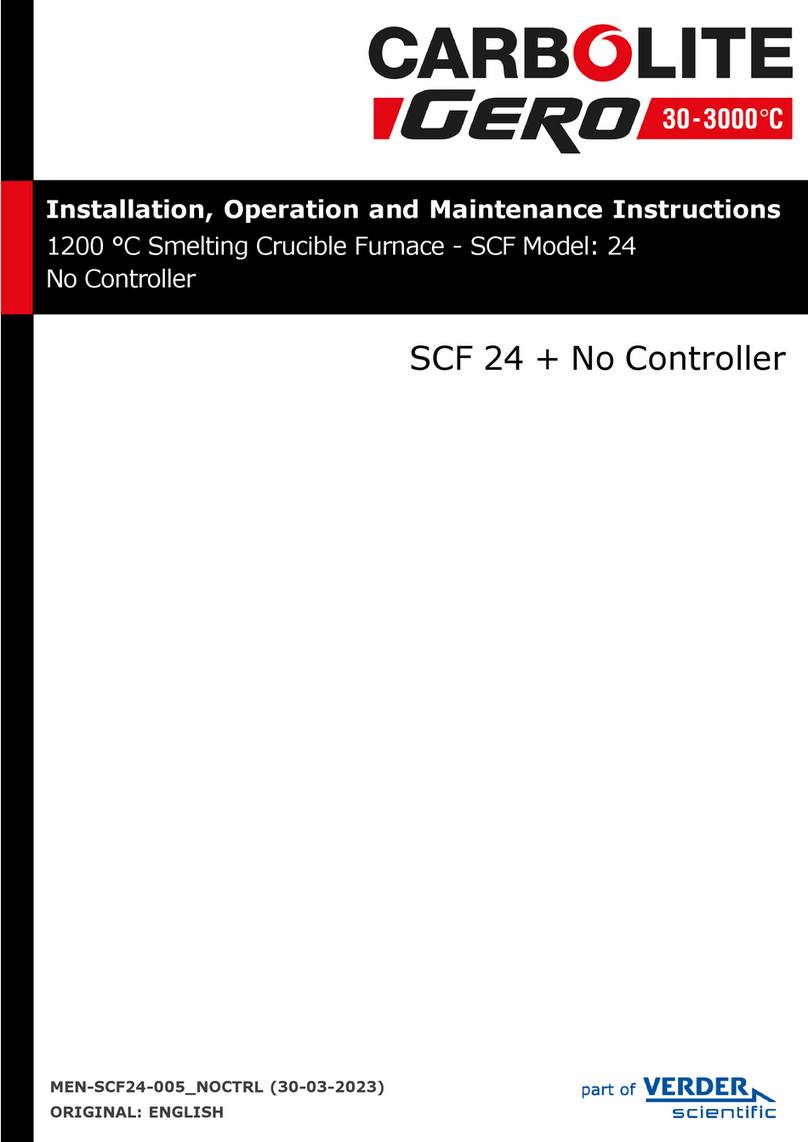
VERDER
VERDER Carbolite Gero SCF 24 Installation, operation and maintenance instructions
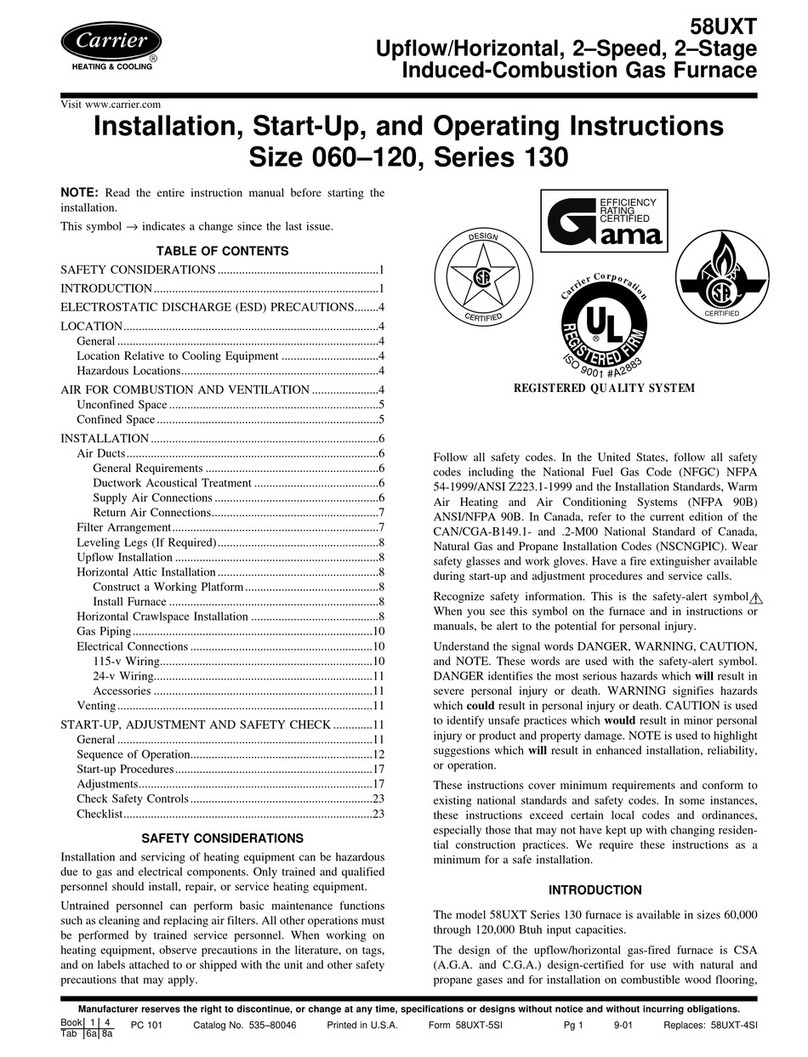
Carrier
Carrier 58UXT Series operating instructions
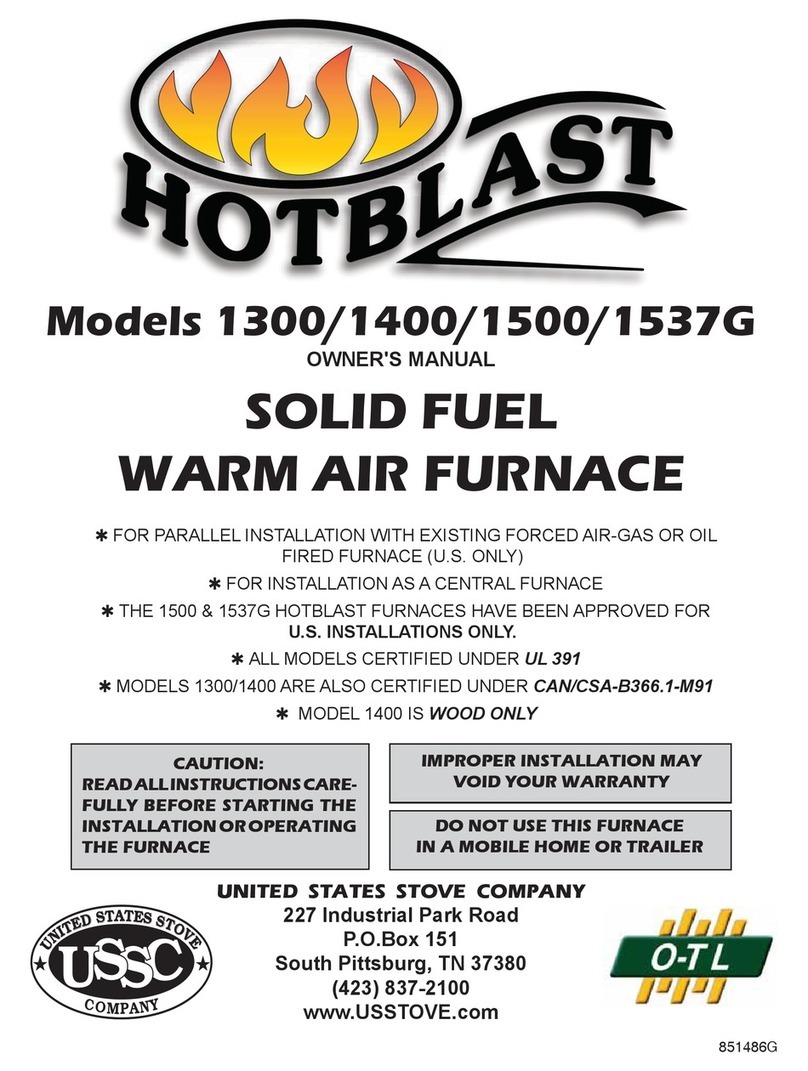
Hotblast
Hotblast 1300 owner's manual
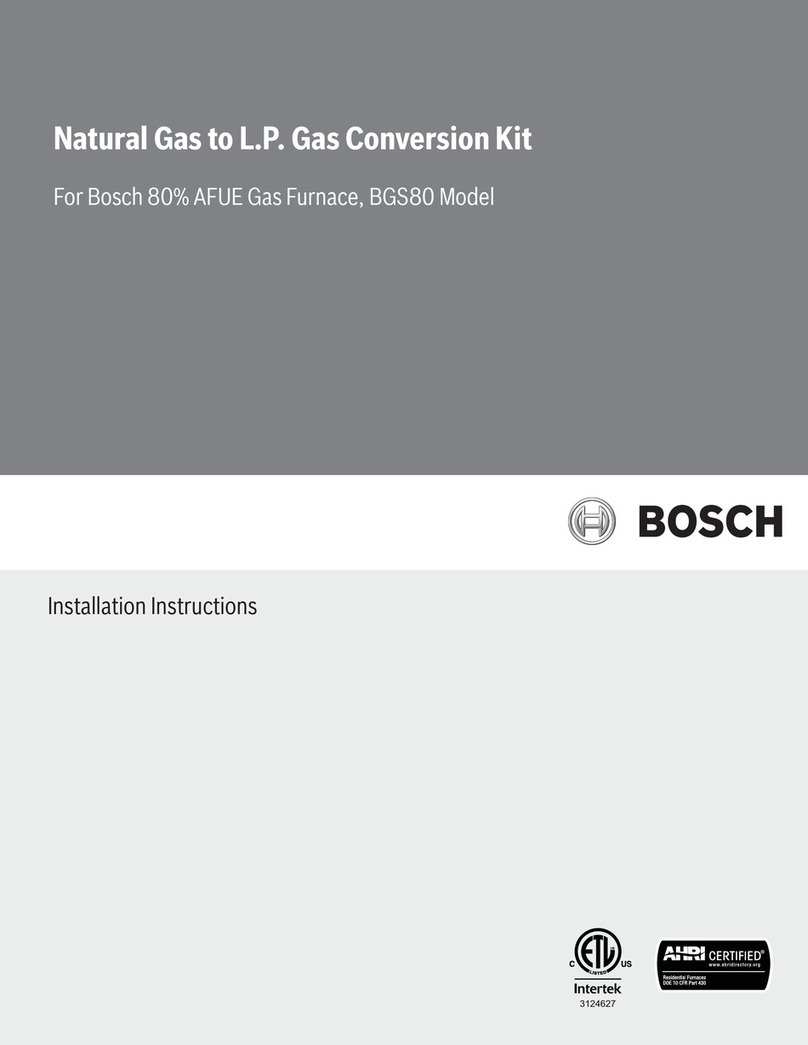
Bosch
Bosch BGS80 installation instructions

Bryant
Bryant 399AAZ User's information manual
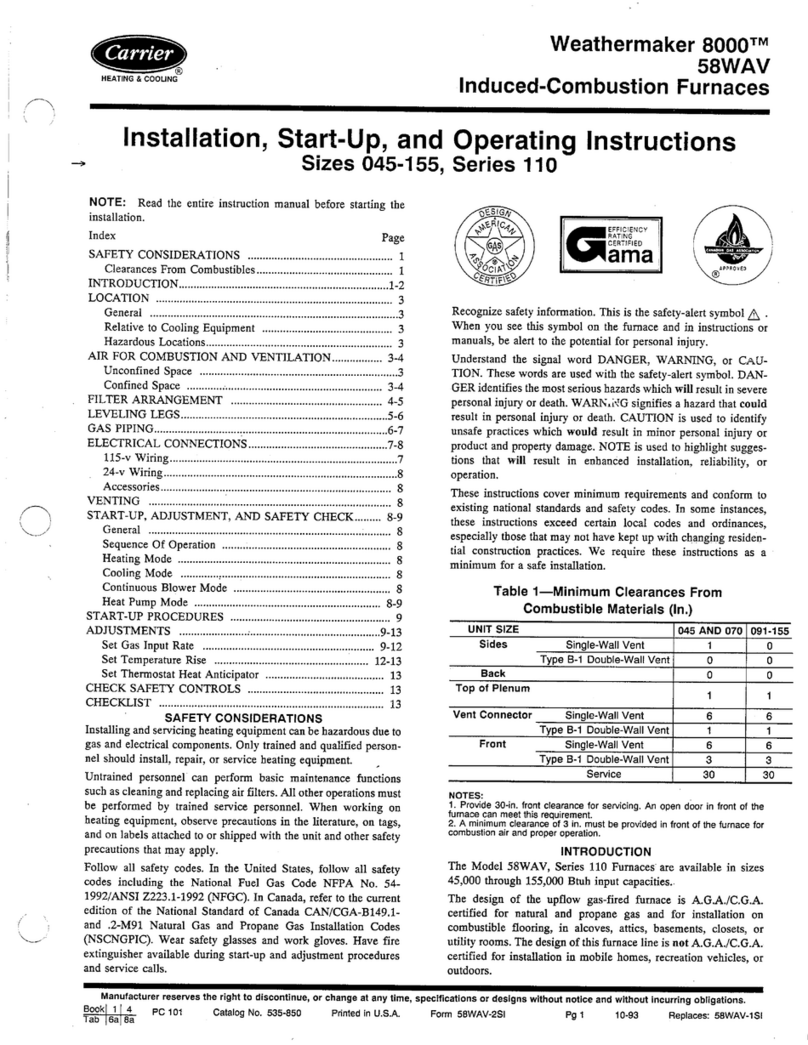
Carrier
Carrier WEATHERMAKER 8000 58WAV Installation and operating instructions

DAKA
DAKA 621 Installation and operation instruction manual
